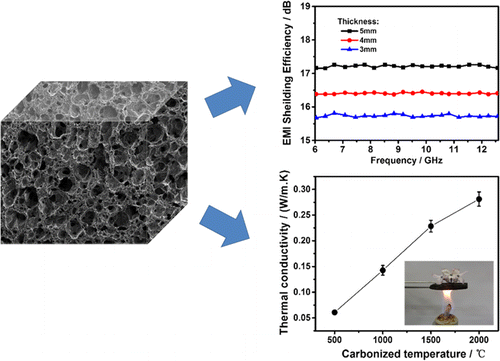Making a multi-use, stiff carbon foam using bread

Sturdy, lightweight carbon foam has many structural and insulating applications in aerospace engineering, energy storage and temperature maintenance. Current methods to create this material run into difficulties when trying to make the product strong, lightweight, environmentally friendly and low-cost. Now, a group reports in ACS Applied Materials & Interfaces a method to produce such a carbon foam by using super-toasted bread.
Carbon foams have a 3-D network that allows them to be lightweight, tolerant of high temperatures and adjustable in their thermal and electrical properties. Many different materials, such as graphene sheets—2-D layers of carbon atoms—and biomass such as banana peels can be used to make these foams, but they are not very stable, are costly to make or have varied inner structures that cannot be adjusted. So Yibin Li, Qingyu Peng and colleagues set out to develop a low-cost, green method to produce a strong, tunable carbon foam.
Using a bread recipe as a guide, the group began by mixing flour, yeast and water, then kneading and baking the dough. The researchers then used a laboratory tube furnace under argon gas conditions to carbonize the product into a hard foam. They tested the foam using several spectroscopy methods and found that it is mechanically stiff, can shield against electromagnetic interference and is much less flammable than current carbon foams. Importantly, this cheap, easy-to-make foam's inner pore structure can be tuned by changing the amounts of yeast and water, which would allow it to be used for a variety of different applications.
More information: Ye Yuan et al. Multifunctional Stiff Carbon Foam Derived from Bread, ACS Applied Materials & Interfaces (2016). DOI: 10.1021/acsami.6b03985
Abstract
The creation of stiff yet multifunctional three-dimensional porous carbon architecture at very low cost is still challenging. In this work, lightweight and stiff carbon foam (CF) with adjustable pore structure was prepared by using flour as the basic element via a simple fermentation and carbonization process. The compressive strength of CF exhibits a high value of 3.6 MPa whereas its density is 0.29 g/cm3 (compressive modulus can be 121 MPa). The electromagnetic interference (EMI) shielding effectiveness measurements (specific EMI shielding effectiveness can be 78.18 dB·cm3·g–1) indicate that CF can be used as lightweight, effective shielding material. Unlike ordinary foam structure materials, the low thermal conductivity (lowest is 0.06 W/m·K) with high resistance to fire makes CF a good candidate for commercial thermal insulation material. These results demonstrate a promising method to fabricate an economical, robust carbon material for applications in industry as well as topics regarding environmental protection and improvement of energy efficiency.
Journal information: ACS Applied Materials and Interfaces
Provided by American Chemical Society




















